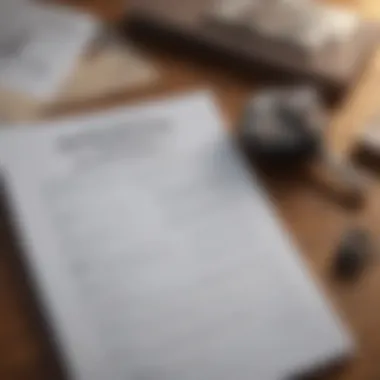Complete Rental Move-in Move-out Checklist for Seamless Transitions


Setting Financial Goals
When venturing into the realm of rental properties, it is crucial to set clear financial goals. Understanding the significance of this initial step lays the foundation for a successful transition process. By establishing realistic financial objectives, individuals can effectively map out their journey, ensuring that each move-in and move-out is financially sound. Tracking the progress of these goals and being willing to adjust them as needed is key to maintaining financial stability and achieving long-term success in rental agreements.
Budgeting and Expense Management
One of the cornerstone elements of managing rental move-ins and move-outs is effective budgeting and expense management. Creating a personal budget specific to the rental transitions allows individuals to allocate funds appropriately, avoiding financial strains and unexpected costs. Moreover, implementing tips for cutting costs and saving money during these transitions is paramount. Utilizing tools and apps dedicated to tracking expenses can provide detailed insights into financial habits, enabling better decision-making throughout the rental process.
Saving and Investing
Building an emergency fund is a critical aspect of rental move-ins and move-outs. It serves as a safety net, offering financial security in unforeseen circumstances related to rental agreements. Exploring various investment options such as stocks, bonds, and ETFs can also help individuals grow their wealth and diversify their financial portfolio. Understanding strategies for diversifying investments is essential in safeguarding against potential risks associated with rental property transitions.
Debt Management
Debt management plays a pivotal role in the financial aspects of rental move-ins and move-outs. Understanding the different types of debt and developing a structured repayment plan are key components in maintaining financial health during these transitions. Exploring consolidation and refinancing options can provide avenues for individuals to streamline their debt obligations, ensuring a more sustainable financial standing throughout rental agreements.
Retirement Planning
Though often overlooked, retirement planning is crucial even during rental transitions. Acknowledging the importance of early retirement planning can significantly impact one's financial future. Familiarizing oneself with different retirement accounts such as 401(k) and IRA can aid in maximizing retirement savings. Leveraging employer matching contributions can further enhance retirement planning efforts, ensuring a comfortable post-rental life.
Pre-Move-In Preparation
Review Lease Agreement
Reviewing the lease agreement is a vital component of pre-move-in preparation. This legal document governs the rental relationship between the tenant and the landlord, detailing crucial aspects such as rent amount, lease duration, deposit requirements, and rules of occupancy. By carefully examining the lease agreement, tenants can clarify any ambiguities, seek clarification on certain clauses, and ensure that they are comfortable with the terms outlined. Understanding the lease agreement thoroughly can prevent future disputes and help maintain a harmonious landlord-tenant relationship.
Schedule Utility Set-Up


Another critical element of pre-move-in preparation is scheduling utility set-up. Ensuring that essential services such as electricity, water, and gas are in place before moving in is imperative for a seamless transition. Coordinating with utility providers to arrange for connections or transfers can prevent disruptions and inconveniences once the tenant occupies the property. By proactively addressing utility set-up during the pre-move-in phase, individuals can settle into their new residence comfortably and without delays.
Document Property Condition
Documenting the property's condition before moving in is a fundamental step in pre-move-in preparation. Conducting a thorough inspection and documenting any existing damages or issues ensures that tenants are not held liable for pre-existing problems upon move-out. By taking photographs, videos, or written notes detailing the property's condition, tenants can provide evidence in case of disputes regarding damages during their tenancy. This proactive approach to documenting property condition promotes transparency and accountability between landlords and tenants.
Move-In Day
In the realm of rental agreements, Move-In Day stands as a pivotal juncture, a moment that can either set a positive tone for the tenancy or unravel into a chaotic ordeal. It serves as the official commencement of your occupancy, where you transition from a mere tenant to the inhabitant of a new space. This section captures the essence of Move-In Day, delineating its significant role within the broader spectrum of rental transitioning.
Perform Initial Inspection
Undoubtedly, the cornerstone of a seamless tenancy resides in the initial inspection conducted on Move-In Day. This meticulous examination of the property's condition serves as a safeguard for both tenant and landlord, ensuring that any existing damages are duly noted to prevent disputes upon move-out. The assessment covers an array of elements, from the walls to the flooring, plumbing fixtures, and electrical appliances. By methodically scrutinizing the premises, you establish a baseline condition that will resonate throughout your tenancy.
Check Appliances and Utilities
Amidst the hustle and bustle of moving, the verification of appliances and utilities often takes center stage on Move-In Day. From the refrigerator's cooling efficiency to the stove's functionality, each appliance undergoes scrutiny to guarantee operational adequacy. Similarly, utilities such as water, electricity, and heating are tested to ascertain seamless functionality. This proactive approach lays the groundwork for a comfortable living environment devoid of unforeseen inconveniences.
Verify Inventory List
A diligent review of the inventory list on Move-In Day mitigates the risk of discrepancies during the tenancy. Comparing the documented inventory with the actual items present in the property safeguards against misunderstandings related to furnishings and appliances. By cross-referencing each item meticulously, you pave the way for a transparent landlord-tenant relationship built on mutual trust and clarity.
During Tenancy
During tenancy is a pivotal phase in the rental journey, playing a crucial role in maintaining a harmonious landlord-tenant relationship. This segment emphasizes the significance of regular maintenance to uphold the property's condition, thus ensuring a comfortable living environment. Through prompt repairs and open communication channels with the landlord or property manager, tenants can address issues efficiently, fostering a positive rental experience.
Regular Maintenance Checks


Regular maintenance checks are imperative to prevent minor issues from escalating into major problems. By conducting routine inspections, tenants can identify potential maintenance needs early, ensuring the property remains in optimal condition. From checking for leaks and electrical issues to monitoring HVAC systems, regular maintenance enhances property value and minimizes disruptive repairs, benefiting both tenants and landlords.
Addressing Repairs Promptly
An essential aspect of tenancy involves addressing repairs promptly. By promptly reporting and fixing maintenance issues, tenants can prevent further damage and uphold the property's integrity. Timely repairs not only maintain the property's appeal but also demonstrate responsibility and care, resulting in a positive rapport with the landlord or property manager.
Communication with LandlordProperty Manager
Effective communication with the landlord or property manager is key during tenancy. Clear and prompt communication regarding maintenance issues, rent queries, or lease agreements fosters transparency and trust. By establishing open lines of communication, tenants can address concerns promptly, seek clarifications, and ensure a harmonious tenancy experience for all parties involved.
Pre-Move-Out Preparation
Pre-Move-Out Preparation plays a crucial role in the seamless transition out of a rental property. It is imperative to approach this stage with meticulous planning and attention to detail to ensure a hassle-free move-out process. By focusing on key elements such as reviewing the notice period and terms, notifying the landlordproperty manager, and organizing cleaning and repairs, tenants can mitigate potential issues and safeguard their security deposit.
Review Notice Period and Terms
One of the primary aspects of Pre-Move-Out Preparation is reviewing the notice period and terms stipulated in the rental agreement. Understanding the specific requirements concerning when notice should be given, whether it is 30 days or otherwise, empowers tenants to comply with contractual obligations effectively. Moreover, familiarizing oneself with the terms related to property condition at the end of the tenancy aids in preparing the residence accordingly, potentially influencing the deposit refund.
Notify LandlordProperty Manager
Communication with the landlord or property manager is paramount during the Pre-Move-Out phase. Notifying them in advance of your intention to vacate the premises allows for open dialogue regarding expectations and responsibilities. This proactive approach enables both parties to address any outstanding issues or concerns promptly, facilitating a smooth handover process. Clear and transparent communication can help avoid misunderstandings and disputes regarding the move-out procedures.
Arrange Cleaning and Repairs
One of the final steps in Pre-Move-Out Preparation is organizing cleaning and repairs within the rental property. Ensuring that the residence is in a well-maintained and clean condition is essential to fulfilling lease requirements and maximizing the chances of a full deposit refund. By attending to any necessary repairs or improvements, tenants exhibit responsibility and care for the property, establishing a positive relationship with the landlord. Engaging professional cleaning services or conducting thorough cleaning independently contributes to a favorable move-out experience for all parties involved.
Move-Out Process


This segment delves into the intricate facets of concluding a rental tenure responsibly. From final property inspections to determining deposit refunds, each element plays a vital role in streamlining the move-out process.
Final Property Inspection
In the realm of rental agreements, the Final Property Inspection serves as the pivotal culmination of a tenant's occupancy. This crucial step involves meticulously assessing the condition of the rental unit against the initial move-in inspection report.
During the Final Property Inspection, tenants are advised to scrutinize every nook and cranny, noting any discrepancies or damages that might have transpired during their stay. Detailed documentation supported by photographs can help mitigate disputes regarding property condition post-occupancy.
Determine Deposit Refund
Determining the Deposit Refund is a critical juncture in the move-out process that necessitates attention to detail and a clear understanding of lease terms. Landlords typically withhold a portion of the security deposit to cover damages beyond normal wear and tear.
Tenants must engage in open communication with the landlord or property manager to comprehend the refund criteria and negotiate any disagreements regarding the deposit deductions. Thorough record-keeping of the property's condition at the commencement and conclusion of the lease can aid in expediting the refund process.
Return Keys and Access Devices
Concluding the tenancy agreement is incomplete without the Return of Keys and Access Devices. Surrendering all keys, fobs, cards, or any access mechanisms ensures that the property remains secure post-occupancy.
Tenants are advised to return all access devices to the landlord or designated personnel by the stipulated timeline to avoid potential disputes or unauthorized access to the rental unit. Acknowledging the return of keys in writing can serve as a safeguard against future claims of non-compliance.
Post-Move-Out
Post-move-out is a crucial phase in the rental process that often gets overlooked. After vacating the rental property, updating your forwarding address is a key task to ensure you receive any important mail or correspondence. Failing to update this information promptly can lead to missed bills, legal documents, or other essential communications. By promptly updating your forwarding address with relevant entities such as the post office, financial institutions, and service providers, you can mitigate any potential disruptions and stay informed.
Update Forwarding Address
Updating your forwarding address is not just a formality but a practical necessity. It involves informing various parties of your new address to ensure the seamless delivery of important documents, packages, and bills. Start by updating your address with the post office to redirect your mail. Next, inform your bank, insurance companies, subscription services, and any other relevant organizations to avoid disruptions in service. Timely address updates can prevent missed payments, policy lapses, or service interruptions, safeguarding your financial and personal interests.
Review Deposit Refund Process
The deposit refund process is a critical aspect of the move-out phase that requires careful attention. Landlords typically return the security deposit within a specified period after move-out, subject to certain conditions. Understanding the deposit refund process outlined in your lease agreement is essential to ensure a smooth transition. Familiarize yourself with any deductions that may be applied, such as cleaning fees or damages, and follow any prescribed procedures for requesting and receiving your refund. By knowing your rights and responsibilities regarding the deposit refund, you can avoid disputes and protect your financial interests.
Legal Review of Final Agreements
Before concluding your tenancy, undertaking a legal review of final agreements is prudent. This entails examining the lease agreement, move-in inspection reports, any additional contracts, and communications with the landlord or property manager. Conduct a thorough assessment to confirm that all terms and obligations have been met satisfactorily. In case of discrepancies or unresolved issues, seek legal guidance to ensure a fair resolution. By conducting a legal review of final agreements, you can safeguard yourself from potential disputes and uphold your rights and responsibilities in the renting process.



